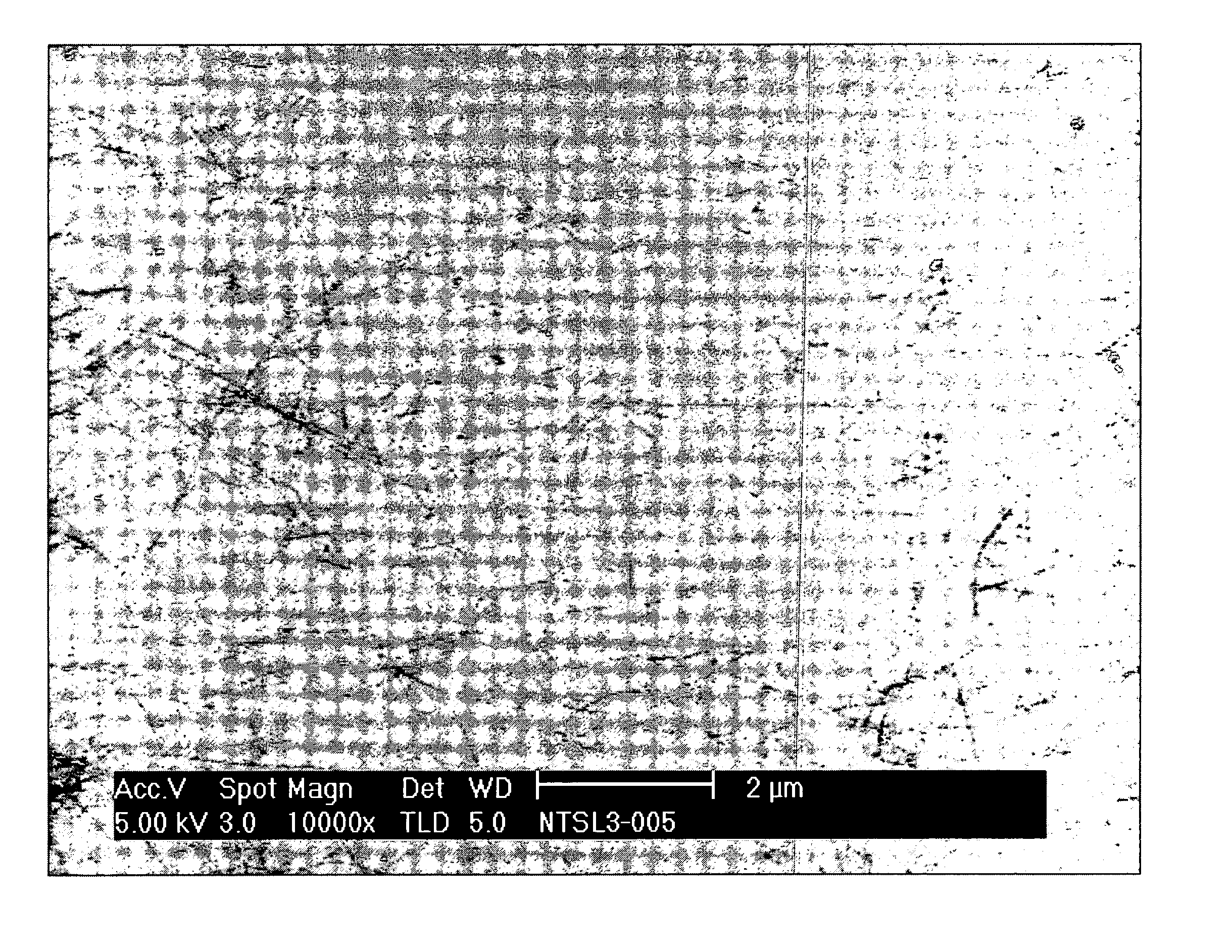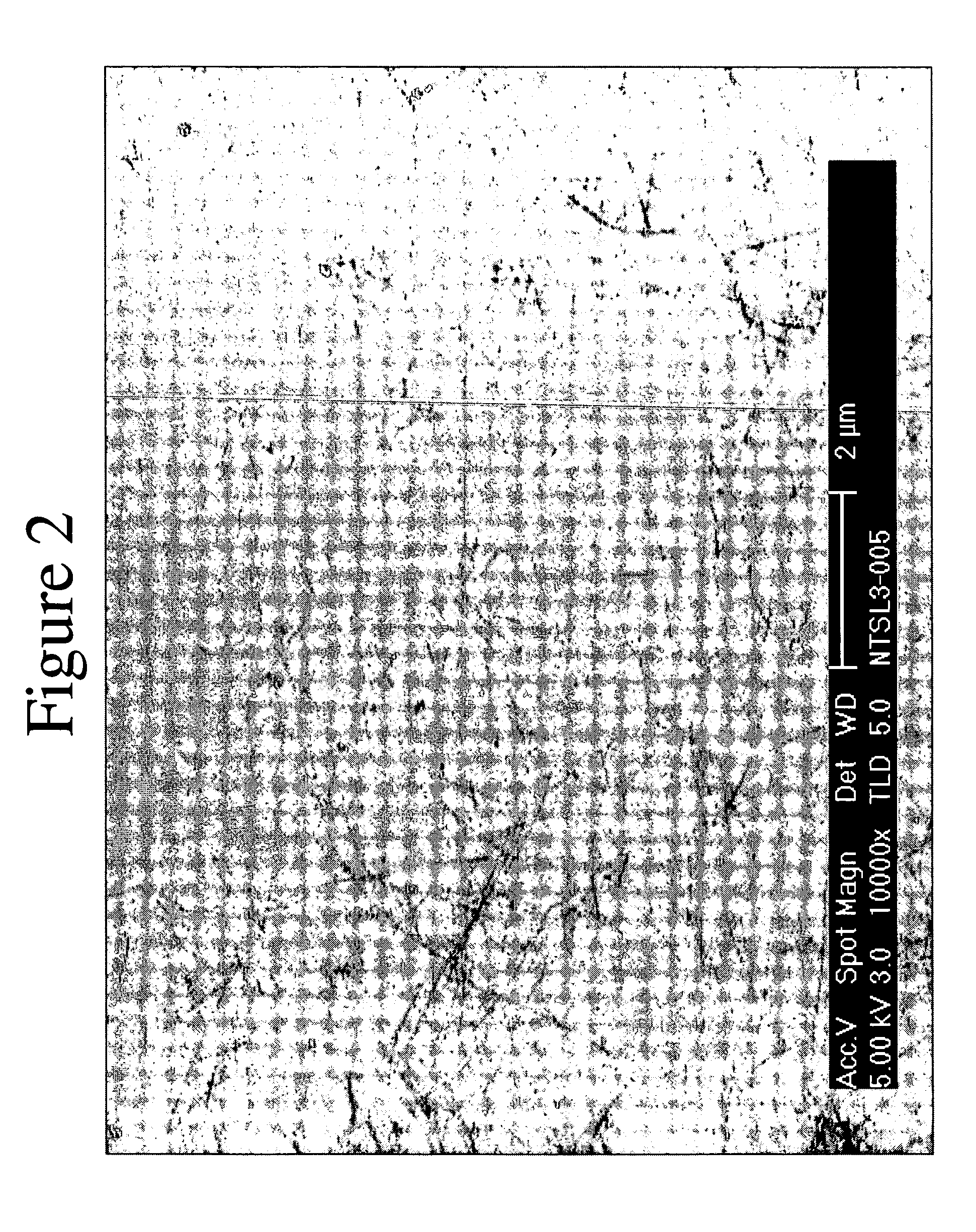Spin-coatable liquid for formation of high purity nanotube films
a nanotube film, high-purity technology, applied in the field of spin-coatable liquids for the preparation of nanotube films, can solve the problems of difficult removal of derivatizing agent, difficult placement of millions of catalyst particles, and difficulty in incorporating swnt into standard microelectronic fabrication processes, etc., to achieve the effect of reducing the level of metal
- Summary
- Abstract
- Description
- Claims
- Application Information
AI Technical Summary
Benefits of technology
Problems solved by technology
Method used
Image
Examples
example 1
[0058] This example describes the purification of nanotubes.
[0059] Single-walled carbon nanotubes (SWNTs) were purified by stirring in 7.7M HNO3 for 8 h followed by refluxing at 125° C. for 12 h. The acid refluxed material was washed with DI water three times by a sonication-centrifugation-decantation cycle. The DI water washed material was then vacuum filtered over a 5 micron filter until a dried SWNT membrane was obtained on the filter paper. This purified SWNT material was collected and used for making a SWNT composition.
example 2
[0060] This example describes the preparation of a nanotube composition and a nanotube article.
[0061] In order to avoid recontamination of the nanotubes, clean room conditions, for example, Class 100 or greater, were maintained during preparation and processing of the nanotube composition. Twenty-one mg of single-walled nanotubes (SWNTs), purified as described above in Example 1 were soaked in 10 mL ethyl lactate (electronics grade—Sigma), ground with a mortar and pestle, sonicated and centrifuged to remove the supernatant. These steps were repeated as necessary to solubilize the carbon nanotubes. The solubilized nanotubes had a final concentration of 21 mg carbon nanotubes per 250 mL ethyl lactate, and the optical density at 550 nm of the solution was measured to be 1.001.
[0062] Each individual step of the solubilization process is detailed in the Table 1 for the solubilization of SWNTs in ethyl lactate (EL). This protocol is illustrative of one means of forming a solubilized nan...
example 3
[0063] This example describes an alternative method of preparing a nanotube composition.
[0064] Twenty-one mg carbon nanotubes were mixed in 10 mL EL and subjected to sonication, centrifugation, decanting of the supernatant and remixing of carbon nanotubes in EL for repeated sonication until the tubes were sufficiently solubilized; i.e., the nanotubes were subjected essentially the same steps as in Example 2, without grinding with mortar and pestle. The steps of the process are shown in Table 2.
TABLE 2Alternate Process Flow Chart for SWNT solubilization in Ethyl-LactateStepProcessDurationRemarks1Place 100 mg in 800 ml ELN / AIn 1 L polypropylene (PP) bottle.2Add Teflon impellersN / AIn 1 L PP bottle3Place on autoshaker100 hPowered through a timer4Collect in a 1 L RBN / AHF cleaned flask, in cleanroom5Bath sonicate1 h5° C.6Centrifuge (15 krpm, 15° C.)2 h6 × 250; Beckman PP bottles7Decant supernatant˜15 minCollect in 1000 ml flask8Check for optical density at 550N / AIf above 1.25 this need...
PUM
| Property | Measurement | Unit |
|---|---|---|
| Diameter | aaaaa | aaaaa |
| Diameter | aaaaa | aaaaa |
| Diameter | aaaaa | aaaaa |
Abstract
Description
Claims
Application Information
 Login to View More
Login to View More - R&D
- Intellectual Property
- Life Sciences
- Materials
- Tech Scout
- Unparalleled Data Quality
- Higher Quality Content
- 60% Fewer Hallucinations
Browse by: Latest US Patents, China's latest patents, Technical Efficacy Thesaurus, Application Domain, Technology Topic, Popular Technical Reports.
© 2025 PatSnap. All rights reserved.Legal|Privacy policy|Modern Slavery Act Transparency Statement|Sitemap|About US| Contact US: help@patsnap.com



